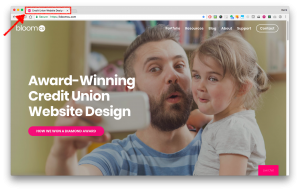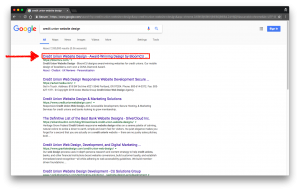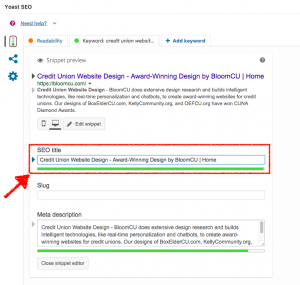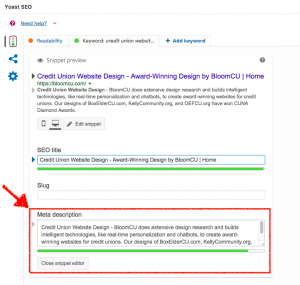Everyone is looking for something to complete them. Some are searching for the perfect partner. Some just want the perfect job or the perfect pet. And some people, somewhere out there, are searching for their dream financial institution. You and your future members could be a match made in heaven, but first, they need to find you. That’s where search engine optimization (SEO) comes in.
SEO is a set of marketing tactics designed to get your credit union website to show up near the top of search results on Google (and other less-relevant search engines) without paying for ads. Showing up near the top of the search engine results page (SERP) can be valuable because the higher your position on the results page, the more clicks you’ll get. Here’s a breakdown of click-through rates for each search ranking, provided by IgniteVisibility:
Google Click-Through Rates in 2017 By Position
Position 1 – 20.5%
Position 2 – 13.32%
Position 3 – 13.14%
Position 4 – 8.98%
Position 5 – 9.21%
Position 6 – 6.73%
Position 7 – 7.61%
Position 8 – 6.92%
Position 9 – 5.52%
Position 10 – 7.95%
There is a lot of mystique and techno-babbling about SEO. And while SEO wizards might know what they’re talking about, you don’t have to delve deep into search engine lore to be successful. In reality, you can often get on the first page of Google’s results just by focusing on the basics. For instance, we got BloomCU.com into the Top 3 of the search results for the term “credit union website design” in about 6-12 months by focusing on just a few basic tactics.
You don’t have to be an expert to make some smart SEO improvements to your website. In this post we’ll explore a few relatively simple ways you can upgrade your SEO and get more people to your website.
The Basics of SEO
How does Google decide which web pages are relevant to a searcher? Google’s search results are based on keywords and link juice (yes, that’s right, link juice).
Keywords
When you type words into Google, those words are used to find web pages that use those same words (or synonyms). Duh, right? The implications are simple: if you want Google to show your credit union website in its search results, you have to use words people are searching for.
When using keywords in your website content, don’t be spammy. Most people hate spam and Google is no exception (but Hawaiians are an exception). If Google thinks you are overusing a keyword phrase just so you will show up higher in its search results, Google will intentionally not show your web page. Google doesn’t want to show spammy results to searchers because that’s bad for Google. Just use keywords naturally in the text of your webpages. In particular, you should use keywords in Page Titles, Meta Descriptions, and Body Content.
Page Title
The term “Page Title” is a little tricky because it doesn’t actually show up in the body content of the page. Rather, the Page Title is what you see in the browser tab. For instance, the Page Title of bloomcu.com is “Credit Union Website Design – Award-Winning Design by BloomCU | Home”:
The Page Title of the homepage on bloomcu.com
Page Titles help users know what a page is about and also show as headings in Google’s search results:
The Page Title of bloomcu.com showing in Position 1 for “credit union website design”
So, for every web page, write a Page Title that’s accurate, concise, and includes a keyword phrase.
Adding a Page Title to a web page varies by content management system (CMS). For BloomCU’s clients, the best way to edit the Page Title is to use the Yoast SEO plugin, which Yoast calls the “SEO Title”:
Editing the “SEO Title” using the Yoast SEO plugin
Meta Descriptions
Meta Descriptions are hidden descriptions used by search engines. These descriptions are not shown anywhere within the content of web pages.
According to Yoast.com, “The meta description is a snippet of up to 320 characters, a tag in HTML, that summarizes a page’s content. Search engines show the meta description in search results mostly when the searched-for phrase is contained in the description. Optimizing the meta description is a very important aspect of on-page SEO .”
Meta description for the homepage of bloomcu.com
Write a good summary of the page’s content and make sure you mention the keyword phrase you are trying to target with that page. (Tip: Keep in mind that if your meta description is more than 135–160 characters, Google may cut it short in the search results.)
Body Content
Unlike meta descriptions, Body Content is what users actually see on a web page. Throughout the body content, use keyword phrases naturally (don’t be spammy, as we mentioned before). For instance, if you have a page about checking accounts, use the phrase “checking account” throughout the page, rather than just an inhouse name for the account, such as “TruChecking”.
Link Juice
Another way Google determines where a web page should be ranked in search results is by analyzing the link juice of a page. Here’s how Crazy Egg explains link juice:
Link juice, link authority, and backlink authority are all different words that mean essentially the same thing. Google analyzes the links that point to a particular webpage to determine what ranking position the webpage should be placed in their search results for a particular keyword query.
If Page A links to Page B, then link juice “flows” from page A to page B and that generally helps page B rank higher on Google. The more pages (and the higher-quality the pages are) that link to page B, the more link juice page B has and the higher it will tend to rank on Google.
Then, Crazy Egg goes on to explain how you can get more link juice:
The smartest way to attract more links to a website is to:
- Create authoritative, useful and trustworthy content
- Improve the strength and popularity of the brand
- Continually advertise, promote and get PR
- Promote good website content and be sure it gets in front of the right audience
Other common practices that businesses use to improve their own link juice include:
- Contributing content to other websites
- Blogger outreach
- Expert quotes or brand mentions
- Product reviews on blogs
- Getting listed in industry-relevant directories
Above, I showed how BloomCU uses keywords to tell Google that bloomcu.com is about “credit union website design.” That was the easy part. The hard part of climbing to the top of Google’s search results was getting link juice. We earned it by creating lots of great content about credit union websites (like this blog post) and getting websites to link to bloomcu.com (for instance, CUInsight.com publishes lots of articles written by BloomCU, and those articles link back to bloomcu.com).
Prioritize Local SEO
Local SEO is one of the most important tactics for credit union websites. Chances are, you aren’t looking to cater to everyone in the world because you have a limited field of membership. That’s why local SEO can be a good way to find members in the communities where your members live.
Note: If you’re not a community credit union (e.g., your field of membership is SEG-based), then SEO may not be a great tactic for you at all, frankly, because most Google searchers wouldn’t be eligible to join your credit union even if they find your website.
How do you do local SEO? First, make sure your credit union has a local online presence. Check out Google My Business if you haven’t already, get registered, and make sure all the info is up to date. If you have more than one branch, you will need to register each location. If someone already made a local entry for your credit union, you can claim it so you can control the listing and make sure all the information is accurate and complete.
Example of a Google My Business Listing for Yolo FCU
You can also check out other local listing sites, such as Yelp, and make sure you’ve got a good presence there.
Next, you’ll want to attract reviews. According to a detailed survey by BrightLocal, 84 percent of people trust online reviews as much as a personal recommendation, and 7 out of 10 customers will leave a review for a business if asked by the business.
The same survey found a correlation between positive reviews and site visits. Customers said that after finding positive reviews, the next action they would take would be to check out the company website. A sizeable chunk also said they would visit the business in person.
You might have a special blurb on your website that asks members to leave a quick review. You could also make the occasional social media post linking directly to a “leave a review” form. Chances are, if someone follows your Facebook page, they’re going to write something positive. You could also ask branch visitors to leave a review, maybe with a written notice strategically placed next to a basket of free candy.
Extra tip: Want to quickly collect testimonials to improve your website conversions? Use your positive Google and Facebook reviews as testimonials.
Revisit Your Site Architecture
Google cannot rank your website correctly if it cannot read your website. Think of Google as a moderately-intelligent robot. It will crawl through your pages, but unlike a human person, it can’t truly explore them unless it understands their structure. It needs a sitemap that’s clearly delineated and organized by hierarchy, not just a jumble of pages.
For information on going the extra mile on site architecture and truly perfecting your navigation, check out our post on tree testing.
Promote high quality content
The “content is king” SEO strategy is more true than ever, particularly as Google continues to crack down on spammy tactics. If you write beautiful, engaging, informative content, and get it in front of your audience, you will get more potential borrowers and members visiting your website. As a credit union, you have built-in knowledge about money and everybody needs to learn how to manage their finances and grow their assets.Use a blog to educate others, and focus on providing quality information, not just quantity. If you have posts that are easy to read and rich in insights, people are far more likely to act on and repost them, even if you only have time to publish one article per month.
You should also share your content on social media. Social media posts immediately create backlinks to your website (transfer link juice to your site) and may even lead to other backlinks. Let’s say you share a blog post about easy budgeting tricks on your Facebook page. A woman sees it, loves it, and posts it on her popular mommy blog—that’s a link you can take straight to the bank.
Use the Google Search Console
Google Search Console is Google’s way of helping you out when it comes to SEO. It lets you collect and analyze important data to see how successful your SEO efforts have been. It also gives you greater control over which sections of your website are searchable. In Google’s own words, these are some of the most useful things you can do with the tool:
- Make sure that Google can access your content
- Submit new content for crawling and remove content you don’t want shown in search results
- Create and monitor content that delivers visually engaging search results
- Maintain your site with minimal disruption to search performance
- Monitor and resolve malware or spam issues so your site stays clean
The Benefits and Costs of SEO
I can tell you BloomCU has benefited significantly from being near the top of search results for “credit union website design” because credit unions seeking a design agency frequently find us through Google. But, despite what some people may tell you, SEO is not for everyone. It can be a very valuable part of an overall marketing strategy, but it requires significant resources to produce good results—just like any other worthwhile strategy. Typically, you have to work on SEO consistently for several months before you’ll start to see increases in your search rankings. So, give some thought to the costs and benefits of SEO for your credit union before jumping in. If you believe SEO is a great strategy for your credit union, stick to the basics, be consistent, be patient, and the rankings will come.
Want more insights?
Get our crazy ideas and doable tips in your inbox.






